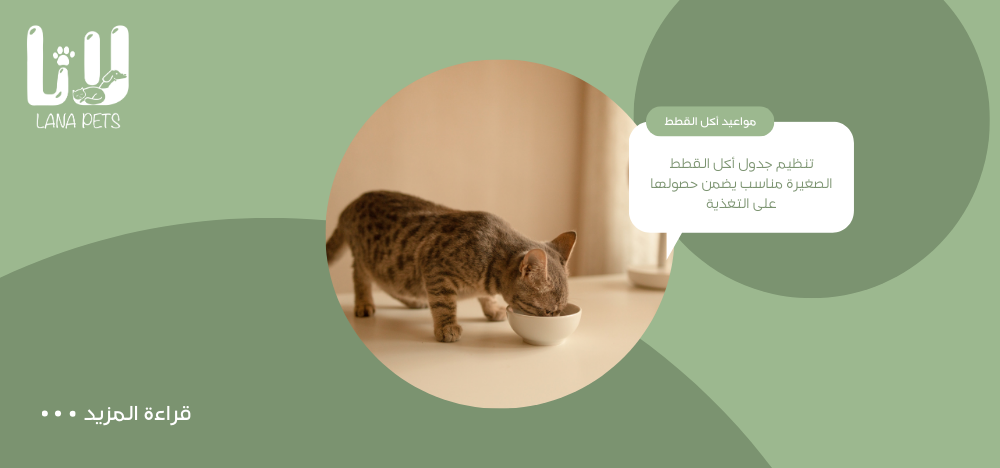
Kitten feeding times for a healthy, happy, and long life
When you welcome a kitten into your home, the first thing that comes to mind is how to care for it and provide it with complete care. One of the most important aspects requiring your attention is establishing a proper feeding schedule for kittens to ensure they receive optimal nutrition during their early stages of development. Knowing what and when to feed your kitten is an essential step in ensuring its health and proper growth.
When do kittens eat and why do they need it?
Imagine you're building a house; every step plays a crucial role in creating a solid structure. Similarly, for your kitten, every meal is an essential step in building a healthy, strong body. A kitten feeding schedule is simply a specific feeding plan that outlines the number of meals your kitten should eat per day, the portion size of each meal, and the type of food appropriate for its age.
Why do we need feeding times for kittens?
Feeding your kitten properly means you'll have a healthier adult cat. Your kitten typically continues to grow until it reaches adulthood, around 10-12 months of age. Your kitten's development is complex, and nutrition plays a major role in ensuring its future well-being. A kitten feeding schedule is an essential tool for tracking its growth and meeting its daily nutritional needs.
This schedule isn't just about feeding times; it's a comprehensive strategy that requires careful knowledge of a kitten's developmental stages and their nutritional needs. From the first weeks when the kitten is completely dependent on its mother's milk or formula, to the transition to solid food and then adult food, the schedule must be flexible enough to accommodate the kitten's needs at each stage.
Adhering to a regular feeding schedule helps determine the appropriate amounts and timing of meals, ensuring your cat receives the energy it needs to thrive. A regular feeding schedule also helps you monitor your cat's weight and health, ensuring it receives proper nutrition without overfeeding or underfeeding.
How much food should you put in a kitten's feeding schedule?
Feeding your kitten the right amount and type of food is essential for their health and well-being. However, the amount of food your adorable pet needs depends on their weight, age, and more. Remember that every kitten has unique needs, so if in doubt, be sure to seek advice from Lana Veterinary Clinic. In the meantime, here are general guidelines for the amounts of food that should be included in a kitten's feeding schedule:
From birth to 4 weeks:
- Food: Mother's milk or kitten milk substitute.
- Quantity: About 5-10 ml per serving.
- Frequency: Every 2-3 hours, equivalent to 8-12 meals per day.
From 4 to 8 weeks:
- Food: A mixture of solid food for kittens with milk or warm water.
- Amount: About 1-2 teaspoons per serving.
- Frequency: 4-6 meals per day.
From 8 weeks to 6 months:
- Food: Dry or wet food for kittens.
- Quantity:
- Dry food: About 20-30 grams per meal, two to three times daily.
- Wet food: about 100-150 grams per day divided into 3-4 meals.
From 6 months to 12 months:
- Food: Food specifically for kittens.
- Quantity:
- Dry food: 30-40 grams per meal, two to three times daily.
- Wet food: about 150-200 grams per day divided into 2-3 meals.
When to start a kitten feeding schedule
Like human children, kittens begin life on a liquid diet and gradually progress to solid foods. Mother cats meet their nutritional needs through their milk from the day the kittens are born until they reach about 4 to 6 weeks of age, when the weaning process begins. During this period, a feeding schedule for kittens should be established.
Why this age in particular?
- Digestive System Development: By this age, a kitten's digestive system has begun to grow and develop enough to allow it to digest solid food.
- Gradual weaning: Gradual weaning from breast milk to solid foods begins at this age, and a meal schedule helps regulate this process.
When can kittens eat adult cat food?
Kittens grow quickly, and before you know it, they'll need to switch to adult cat food. For most cats, the kitten food should be changed around their first birthday. It's not recommended to introduce adult cat food directly to kittens. After several weeks of continuous nighttime feeding, it's understandable to introduce kittens to solid foods earlier. However, the ideal age to introduce solid foods to hand-reared kittens is still four weeks of age, and certainly not before three weeks of age. Here's a step-by-step explanation of the process:
- Different Nutritional Needs: Kittens have different nutritional needs than adult cats. They require higher amounts of protein, fat, and calories to support their growth and development. Adult cat food may not provide these nutrients in adequate quantities.
- Difficulty in digestion: The digestive system of kittens is still developing, and they may have difficulty digesting adult cat food, which is typically less nutrient dense and more difficult to digest.
- Nutritional deficiencies: Feeding adult cat food may lead to deficiencies in some essential vitamins and minerals that kittens need for healthy growth.
Providing your kitten with proper nutrition isn't just about putting fresh food in a clean bowl. Your kitten's nutritional needs will change as their body grows through adolescence and into adulthood. Proper nutrition through a kitten feeding schedule will help them mature into strong, healthy adults. The nutritional needs of kittens and cats vary greatly, and it's important to provide your pet with excellent nutrition appropriate for their age.

